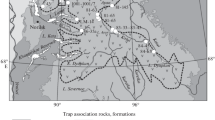Abstract
In contrast to most twentieth-century eruptions of Kelud volcano (eastern Java), the 10 February 1990 plinian eruption was not accompanied by lake-outburst lahars. However, at least 33 post-eruption lahars occurred between 15 February and 28 March 1990. They swept down 11 drainage systems and travelled as far as 24 km at an estimated mean peak velocity in the range of 4–11 m s–1. The deposits (volume ≥30 000 000 m3) were approximately 7 m thick 2 km from vent, and 3 m thick 10 km from vent, on the volcaniclastic apron surrounding the volcano. Subtle but significant sedimentological differences in the deposits relate to four flow types: (a) Early, massive deposits are coarse, poorly sorted, slightly cohesive, and commonly inversely graded. They are inferred to record hot lahars that incorporated pumice and scoria from pyroclastic-flow deposits, probably by rapid remobilization of hot proximal pyroclastic flow deposits by rainfall runoff. Sedimentary features, such as clasts subparallel to bedding and thick, reversely to ungraded beds, suggest that these flows were laminar. (b) Abundant, very poorly sorted deposits include non-cohesive, clast-supported, inversely graded beds and ungraded, finer-grained, and cohesive matrix-supported beds. These beds display layering and vertical segregation/density stratification, suggesting unsteady properties of pulsing debris flows. They are interpreted as deposited from segments of flow waves at a middle distance downstream that incorporated pre-eruption sediments. Sedimentological evidence suggests unsteady flow properties during progressive aggradation. (c) Fine-grained, poorly sorted and ungraded deposits are interpreted as recording late hyperconcentrated streamflows that formed in the waning stage of an overflow and transformed downcurrent into streamflows. (d) Ungraded, crudely stratified deposits were emplaced by flows transitional between hyperconcentrated flows and streamflows that traveled farther downvalley (as far as 27 km from the vent). At Kelud, the transformation of flow and behavior occurs within only 10 km of the source, at the apex of the alluvial fans. The rapid change of flow behavior is attributed to the low fines content and to the unsteady flow regime, which may be due to: (a) the rapid deposition of bedload, owing to the break in channel gradient close to the vent and to changes in channel cross-section and roughness; and (b) the very low silt+clay content in the non-cohesive deposits. These deposits mix with water to produce streamflows.
Similar content being viewed by others
Author information
Authors and Affiliations
Additional information
Received: 27 June 1997 / Accepted: 5 January 1998
Rights and permissions
About this article
Cite this article
Thouret, JC., Abdurachman, K., Bourdier, JL. et al. Origin, characteristics, and behaviour of lahars following the 1990 eruption of Kelud volcano, eastern Java (Indonesia). Bull Volcanol 59, 460–480 (1998). https://doi.org/10.1007/s004450050204
Issue Date:
DOI: https://doi.org/10.1007/s004450050204




